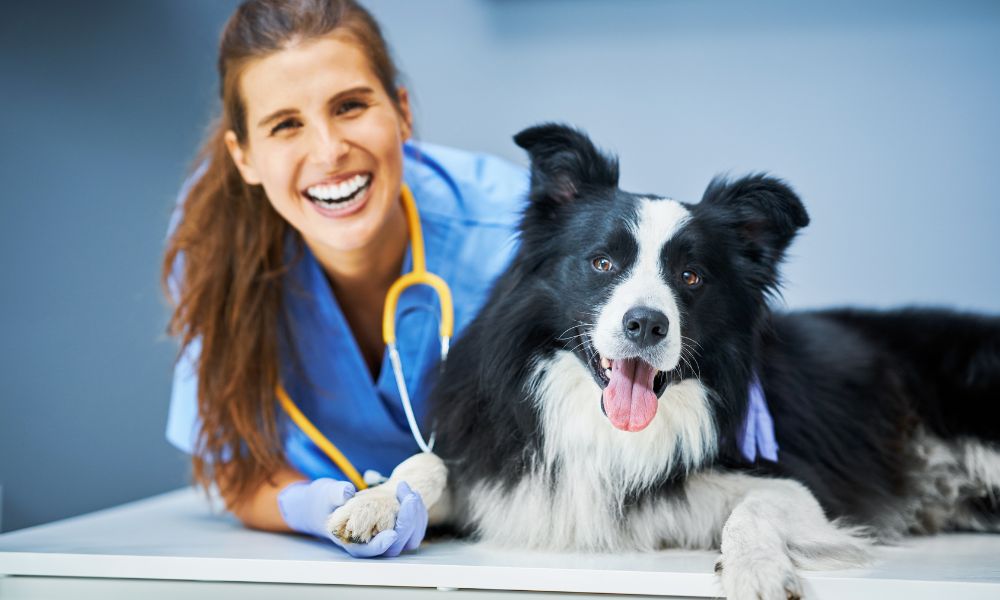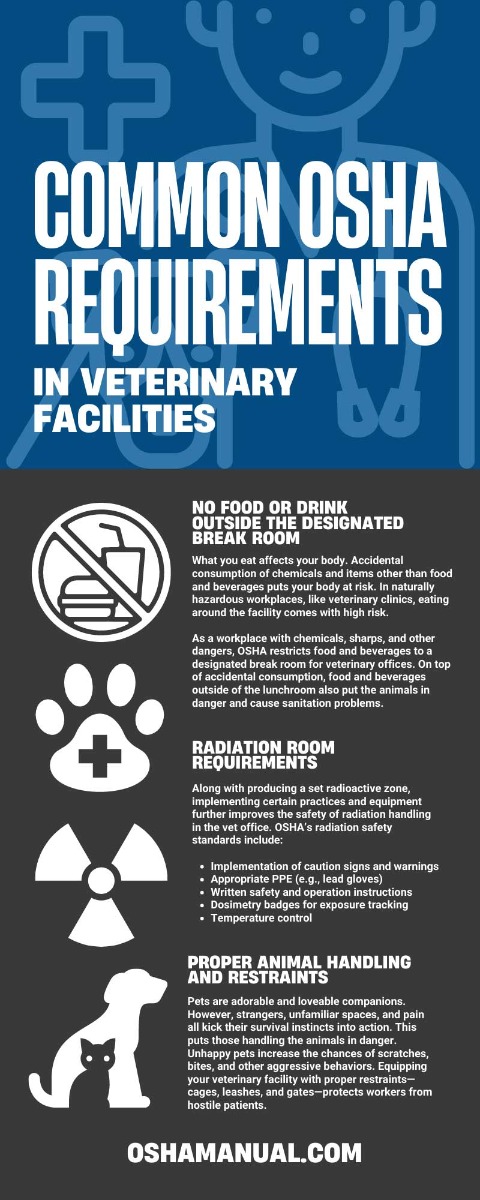
Veterinary facilities keep the health and safety of people’s beloved pets in top condition. Meanwhile, the Occupational Safety and Health Association maintains the well-being of those working in a veterinary clinic to ensure they provide quality care.
Producing a safe and healthy work atmosphere involves a lot of moving parts, especially in health-care services. It involves disease control, specific safety practices, and various regulation implementation. OSHA establishes protocols and standards covering many workplace health and safety considerations, guiding workplaces to generate a better environment for their staff.
Adhering to their requirements ensures your employees and clients stay happy, healthy, and safe from a range of possible dangers. Here are 10 common OSHA requirements in veterinary facilities to follow and upgrade your clinic’s working conditions.
1. No Food or Drink Outside the Designated Break Room
Lunch breaks and other moments of pause during the workday provide many benefits. They allow people to refresh, care for themselves, and meet their basic needs while on the clock. However, eating and drinking come with some health and safety risks.
Accidental consumption of chemicals and items other than food and beverages puts your body at risk. In naturally hazardous workplaces, like veterinary clinics, eating around the facility comes with high risk.
As a workplace with chemicals, sharps, and other dangers, OSHA restricts food and beverages to a designated area for veterinary offices. On top of accidental consumption, food and beverages outside of such an area also put the animals in danger and can cause sanitation problems.
2. Closed-Toed Shoes in the Dress Code
Certain dress codes create work armor. Clothing provides a physical barrier on the job. Like in many workplaces, OSHA enforces closed-toed shoes for veterinary office dress codes. Closed-toed shoes protect employees’ feet from chemical spills, falling sharps, and animal scratches. Closed-toed shoes also keep workers’ feet clean.
3. Hearing Protection in PPE Standards (if applicable)
Like appropriate dress wear, personal protective equipment provides a safety barrier for workers to wear. Common PPE in a vet office includes:
• Gloves
• Aprons
• Face masks
• Lab coat
• Scrubs
• Eye protection
OSHA can also enforce those in a veterinary office to wear hearing protection along with general PPE if noise is a potential workplace hazard.
Certain animals may make loud noises, especially when stressed, in pain, or kept in a restricted area. Wearing ear protection prevents the cacophony of noisy animals from rupturing ear drums and distracting employees.
4. Radiation Room Requirements
Chemotherapy and radiographs produce and use radiation, putting people at risk of high exposure. To control radiation hazards in the vet office, OSHA recommends clinics designate a single-use space for radioactive treatments, containing and controlling radioactivity in the facility.
Along with producing a set radioactive zone, implementing certain practices and equipment further improves the safety of radiation handling in the vet office. OSHA’s radiation safety standards include:
• Implementation of caution signs and warnings
• Appropriate PPE (e.g., lead gloves)
• Written safety and operation instructions
• Dosimetry badges for exposure tracking
• Temperature control
5. Eyewash Stations in Labs
Eyewash stations are critical for hazard exposure emergency plans. They flush out chemicals and small debris from the eyes. OSHA requires all labs to contain at least one eyewash station for maximum safety.
Labs handle a variety of chemicals and hazardous materials. Eyewash stations in any area that handles toxic substances provide easy access to a first-aid response and keep staff safe.
6. Clearly Marked Signage and Identification
Cautionary signs and hazard identification allow workers to act accordingly to the circumstances. They ensure people follow best safety practices, minimizing workplace dangers and accidents. Along with hazard warnings, OSHA also requests vet clinics to put up other health and safety signs.
Posters detailing best practices and safety plans, labels identifying hazards on certain products, and clear exit routes also provide sufficient and effective safety signage. In a veterinary hospital, multiple dangers lurk, from bloodborne diseases to chemical and radiation exposure. Proper markings and identifications ensure workers stay safe and handle hazards appropriately.
7. Emergency Action and Prevention Plans
Emergency plans provide detailed response guidelines for if an emergency occurs. Prevention plans create certain methods and best practices for avoiding emergencies. Both plans provide detailed guides for handling certain scenarios.
All workplaces risk facing potential hazardous encounters, from fires to weather influences. Veterinary hospitals add exposure to bloodborne pathogens, hazardous drugs, and radiation to that list, as well as handling dead carcasses and toxic waste. Emergency and prevention plans better prepare a veterinary facility for possible worst-case scenarios and hazard control. In an adrenaline-inducing accident, following clear and concise guidelines helps people push through panic and handle the situation successfully.
8. Proper Animal Handling and Restraints
Pets are adorable and loveable companions. However, strangers, unfamiliar spaces, and pain all kick their survival instincts into action. This puts those handling the animals in danger. Unhappy pets increase the chances of scratches, bites, and other aggressive behaviors. Equipping your veterinary facility with proper restraints—cages, leashes, and gates—protects workers from hostile patients.
9. Separating Hazardous and Regular Waste
In a veterinary facility, hazardous waste comes in many forms, from animal bodily fluids and blood to drugs and chemicals. Without the proper protocols, hazardous waste causes numerous health and safety issues. It increases the risk of spreading infections and contaminations.
OSHA’s standards for handling regulated medical waste include separate bins, clear labeling and identification, hands-free disposal systems, and proper termination methods. Following OSHA’s hazardous waste protocols keeps any dangerous discharge contaminated and secured.
10. Administrative Documentation
Administrative documentation builds a business’ portfolio out of its past records and important paperwork. OSHA requires proper documentation of violation citations, a summary of illness and injury reports, and safety procedures and plans. These documents help you keep track of how you can improve your workplace’s health and safety and provide referrals and reminders of best practices. They allow you to learn from past mistakes, challenge potential risks, and plan ahead for possible scenarios.
These 10 OSHA requirements in veterinary facilities improve your clinic’s health and safety, producing ideal working conditions. They allow vets to carry out their jobs with minimal accidents, ensuring people’s pets remain in safe hands.
Improve your veterinary office’s health and safety standards with OSHA training for veterinary hospitals from Gamma Compliance Solutions. Our training provides detailed courses on all things OSHA within the veterinary industry, from OSHA protocols to compliance education requirements. Check out our courses and manuals and upgrade your clinic into a safer and healthier workspace.

